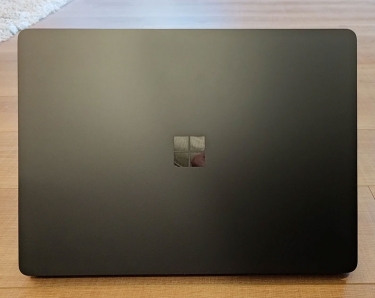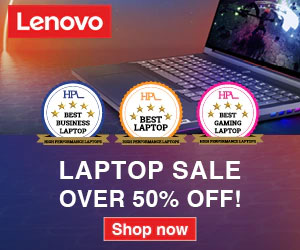| Screen | 15-inch, glossy, 120Hz, 2,496 x 1,664, IPS display |
| Processor | 4GHz Snapdragon X Elite (12 Core) CPU |
| Memory | 32GB LPDDR5 RAM |
| Graphics | Qualcomm Adreno VPU |
| Hard drive | 1TB |
| Connectivity | Wi-Fi 7 Bluetooth 5.4 2 x USB-C 4 1 x USB-A 3.1 1 x 3.5mm audio jack 1 x MicroSD card reader |
| Speakers | Yes (unspecified) |
| Extra Security | Windows Hello (webcam) |
| Webcam | Full HD |
| Battery | 66Wh |
| Dimensions | 329 x 239 x 18mm |
| Weight | 1.68KG |
| SKU | 7th Edition |
Features, Ergonomics and Design
Our review unit of Microsoft’s Surface Laptop 7 has a black, anodised, aluminium-alloy chassis (which uses two-thirds recycled material) and it looks very smart both in an office environment and when out and about. The black version denotes the top specification but a lesser variant is available in Platinum regalia. It’s very solidly built and oozes luxurious quality. The glossy Windows logo on the lid makes for a nice, lone flourish.

Opening it up reveals the 15-inch, IPS display and its somewhat-unusual 2,496 x 1,664 resolution. It displays a bright, crisp and clear Windows Desktop with vibrant colours. It supports HDR which provides impressive contrast although detail can be lost in both the brightest and darkest areas. Colourful and monochromatic transitions are all impressively smooth.
The panel has a dynamic refresh rate which can change (or be forced) to 60Hz or 120Hz according to whether performance or battery-life is the priority. At 120Hz motion is smoother but it can’t mask the screen’s slow pixel response time, so fast-moving content can get blurry. It’s only competitive gamers that would grumble, though, and this laptop isn’t for them.
The Surface Laptop’s 10-point touchscreen is responsive, but the glossy finish does mean that it turns into a black mirror in certain lighting conditions and when dark content is being viewed. This was a formal gripe highlighted in our business laptops feature, so it won’t be the best choice for most workers who look at the screen all day.

The Surface Laptop’s speakers are excellent. Their specs aren’t specified but they get loud, with great fidelity from top to bottom and plenty of punchy bass.
Above the screen is a Full HD webcam (with Windows Hello facial recognition, login) that captures an impressively clear image with minimal grain in low light. The dual-microphone array captures impressively clear audio, even in noisy environments.
Beneath the Surface Laptop 7’s screen is a low-travel, Scrabble-tile keyboard that’s particularly comfortable and accurate to type upon for extended periods. There’s no number pad and the up-and-down arrow keys are squished, but these foibles don’t impact upon usage too much.
The trackpad is smooth and accurate with very low actuation pressure required to activate its buttons.
However, the core feature of Microsoft’s Surface Laptop 7 is the Copilot+ Ai functionality. We won’t go into all the features again – you can read about them here – but the interactive chat function alone looks like it could indeed be game-changing. It’s so quick and responsive! The downside to this is the reduced functionality afforded by the ARM processor. Many of our standard apps wouldn’t run, including Adobe Premiere. Others, like Cinebench, would run in a virtualised mode with fluctuating scores and results files that we couldn’t save.
The improvements in software compatibility, with this ARM-based Copilot+ laptop, are supposed to be dramatically better than the reduced, Windows for ARM and Windows RT ancestors of the past. But, there are still core apps that don’t work at all, even with emulation software. The biggest potential problem is that Intel’s Lunar Lake platform launches in September and, even though we’ve been force-fed a LOT of Intel Kool-Aid on the matter, it looks like Copilot+ will run just as well on these next-gen, fully featured, Intel-based laptops AND that the huge number of improvements made – by overhauling their Meteor Lake processors – could rival the battery life too.
If you’re desperate to get a Copilot+ laptop right now, the next problem is that, according to Microsoft’s store, you’ll still have to wait until the end of this month before getting one. So, for the moment, I recommend you wait and see how true Intel’s claims are before buying an ARM-based model. It won’t be long, now.
Still, in terms of Features, Ergonomics and Design the Microsoft Surface Laptop 7 is great to use – as long as you don’t get stuck with app compatibility. However, for now, the bonus points it gets for supporting Copilot+ features are offset by those it loses for its limitations.
Connectivity
Microsoft’s Surface Laptop 7 has a decent functionality. To wit:

On the left of Microsoft’s Surface Laptop is a 3.5mm audio jack, a USB-A 3.2 Gen 1 port and two USB 4 ports.

Inside there’s Wi-Fi 7 and Bluetooth 5.5. I’d like to see more wired ports, but that’s still an impressive, ultraportable complement of connectivity.
Features, Ergonomics and Design Score: 3.9 / 5
Performance
Inside Microsoft’s 7th-Edition Surface Laptop is an ARM Snapdragon X Elite (X1E-80-100) processor which has 12 cores that can all operate at 3.4GHZ while two can boost to 4GHz. There’s also a Qualcomm Adreno graphics chip and the feted Qualcomm Hexagon NPU which is capable of 45 Trillion Operations Per Second (TOPS).
It’s partnered by a fast, 1TB NVMe hard drive plus 32GB of low-power, LPDDR5 RAM.
Benchmarking it was tricky because it simply wasn’t compatible with many of our tests, including PCMark 10. It did run PCMark 10’s ‘Applications’ test and scored 13,006 which might be good or bad. I’ve little idea at this stage. That said, I found that all office-type applications ran quick and lag free like on most other modern laptops.
It did run the Cinebench CPU-based rendering tests, although scores bounced around significantly (it sees the CPU as a virtual processor). In the quick R15 test, 2,370 was its best score. This represents a fairly impressive (for an ultraportable) score of 2.3 / 5. In the longer R23 test, the Surface Laptop 7 managed 10,338 (Score: 1.8 / 5) which isn’t bad. It’s not a rendering laptop but it will manage occasional tasks. That said, remember that it’s not compatible with Premiere Pro but it is compatible with DaVinci Resolve.
As for 3D, the Qualcomm Adreno GPU managed to run some of our 3DMark game benchmarks. It wouldn’t run the difficult ray-tracing tests, Speed Way and Port Royal. Neither can laptops which rely upon Intel’s Arc graphics.
However, in the AAA-game-title-mimicking Time Spy and Fire Strike Extreme tests, the Laptop scored 1,914 (average 10.5fps) and 2,895 (average 12.5fps). That puts it in line with last-generation Intel Xe graphics (the newer, multicore, Meteor Lake Arc GPUs offer around double this and Lunar Lake’s Xe2 GPU is supposed to be faster still). It means that you may be able to play some mainstream games on this Surface, but you’ll need to significantly drop the resolution and detail settings.
In the lesser 3DMark Night Raid test which apes casual and competitive games, Microsoft’s Surface Laptop scored 25,891 which is an average of 134.5fps. While that’s lower than Intel-based rivals, it shows that it can play casual and competitive games. Just remember that the screen isn’t quick enough to render fast-moving shooters without blur.
As for cooling, the Surface Laptop 7 could get a little warm under load but the fan only made a low whoosh which quickly cooled it back down. Heat and thermal throttling weren’t significant issues.
Portability and Battery Life
On the one hand, the Surface Laptop 7 feels high-quality and solid enough to easily survive life on the road. The Corning Gorilla Glass screen helps this robustness more. The downside is that it’s not the lightest in its ultraportable class at 1.68KG.

Microsoft’s Surface Laptop 7 also does (relatively) well at fending-off fingerprints.
The power supply is small and, with the two-pin, radio cable, weighs only 259g. It, like its forbears, has a USB-A charger built into it. Just note that it gets very warm under load.
Battery life is a core benefit of ARM’s processors. Our problem was that it wouldn’t run our PCMark 10 Modern Office Battery Test. As such, we ran its Applications Battery Benchmark and it managed a very impressive 24 hours and 10 minutes.
It’s fair to say that battery life wasn’t an issue whenever we used it, but we’re very keen to see if Lunar Lake comes close in the coming weeks.
Portability and Battery Life Score (4.1 / 5)
Price and Availability
Microsoft’s store states that the 7th Edition Surface Laptop will be delivered by August 30 at the earliest. It costs $3,699 which is not cheap. Lesser versions and 13-inch alternatives are also available. There are many x86 Windows laptops that are cheaper and represent better value propositions, so you’ll be paying a premium for CoPilot+ functionality.
Price: 2.3 / 5
Value: 3.4 / 5
Conclusion
ARM had a great opportunity to change the laptop world with its head start on CoPilot+ laptops and the functionality is intriguing. However, the price being charged is more-expensive than regular x86 laptops and, with Lunar Lake launching in a matter of weeks, we could very well see ARM-based alternatives looking lost in a sea of cheaper, better, unlimited alternatives.
In many ways, it feels like a repeat of the Windows Phones, but in reverse… Microsoft tried to break into the phone market but the existing Apple and Android user base saw few benefits to switching to a platform that offered fewer apps and only some Windows-Office integration benefits, even though the hardware worked well. Now, here’s phone-based behemoth ARM, seeking to break into the laptop space with similar promises.
Time will tell, but we’ll know whether this technology and Microsoft’s Surface Laptop 7 is transformative or moribund in a matter of weeks.
Overall: 2.9 / 5
This article originally appeared for High Performance Laptops on SMBtech.











































